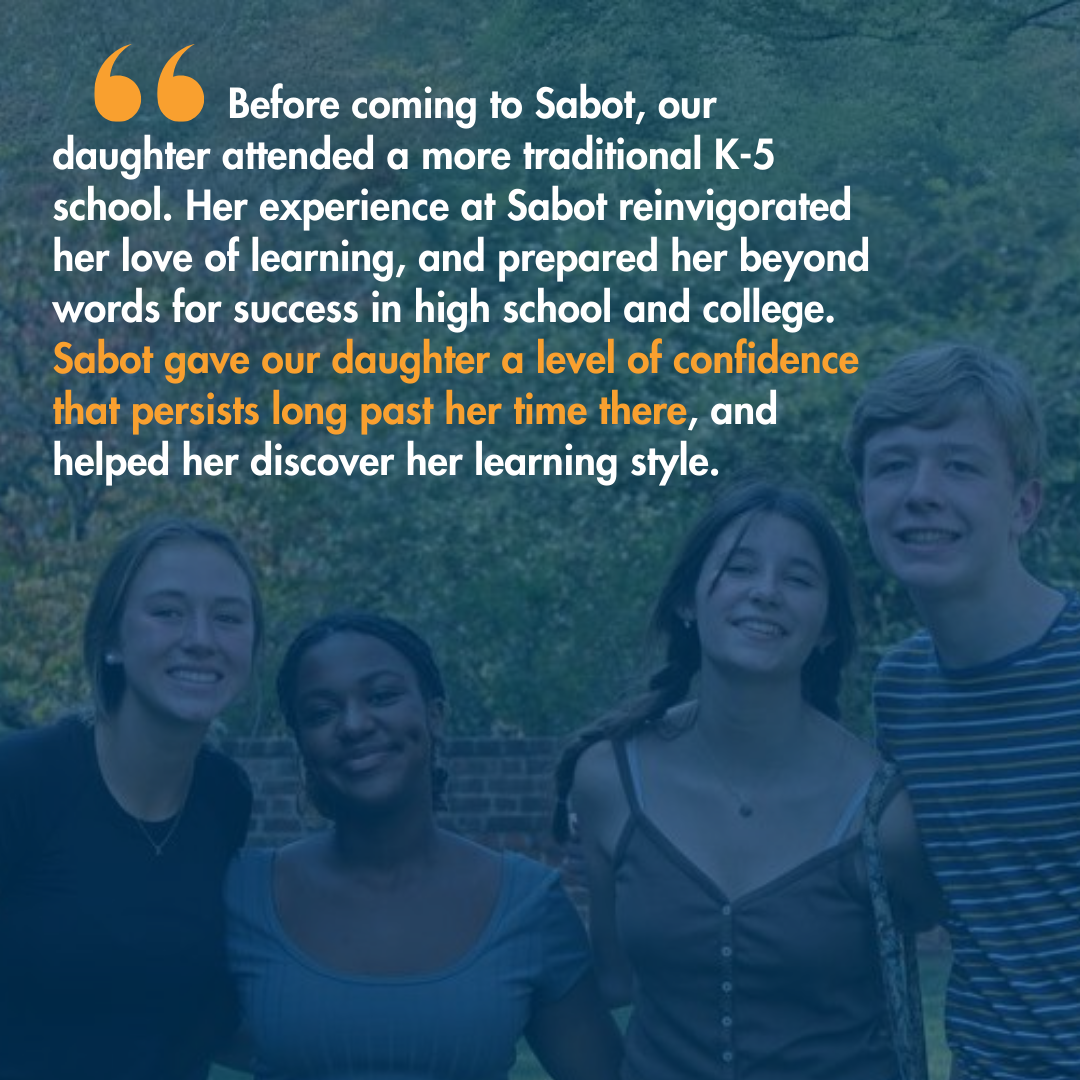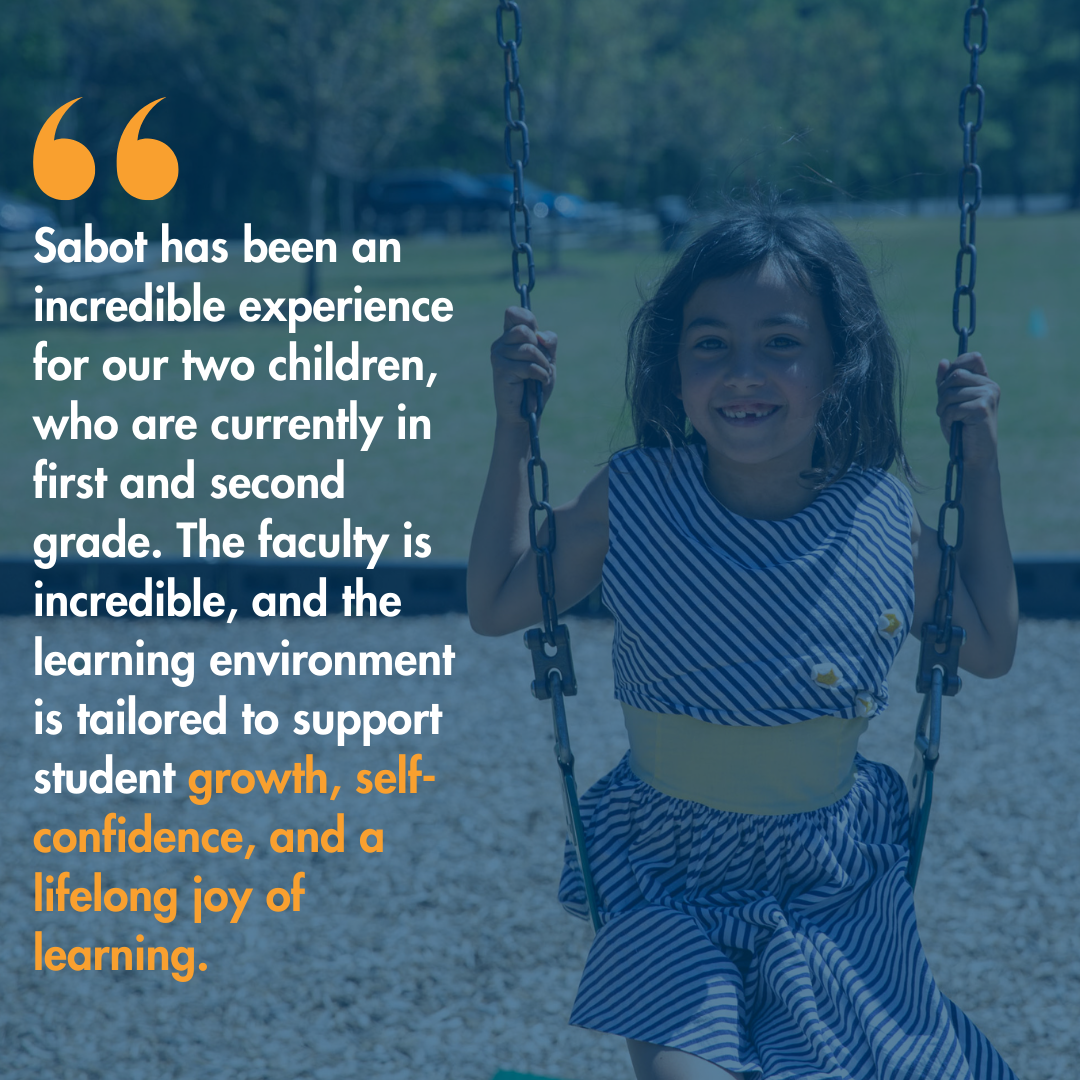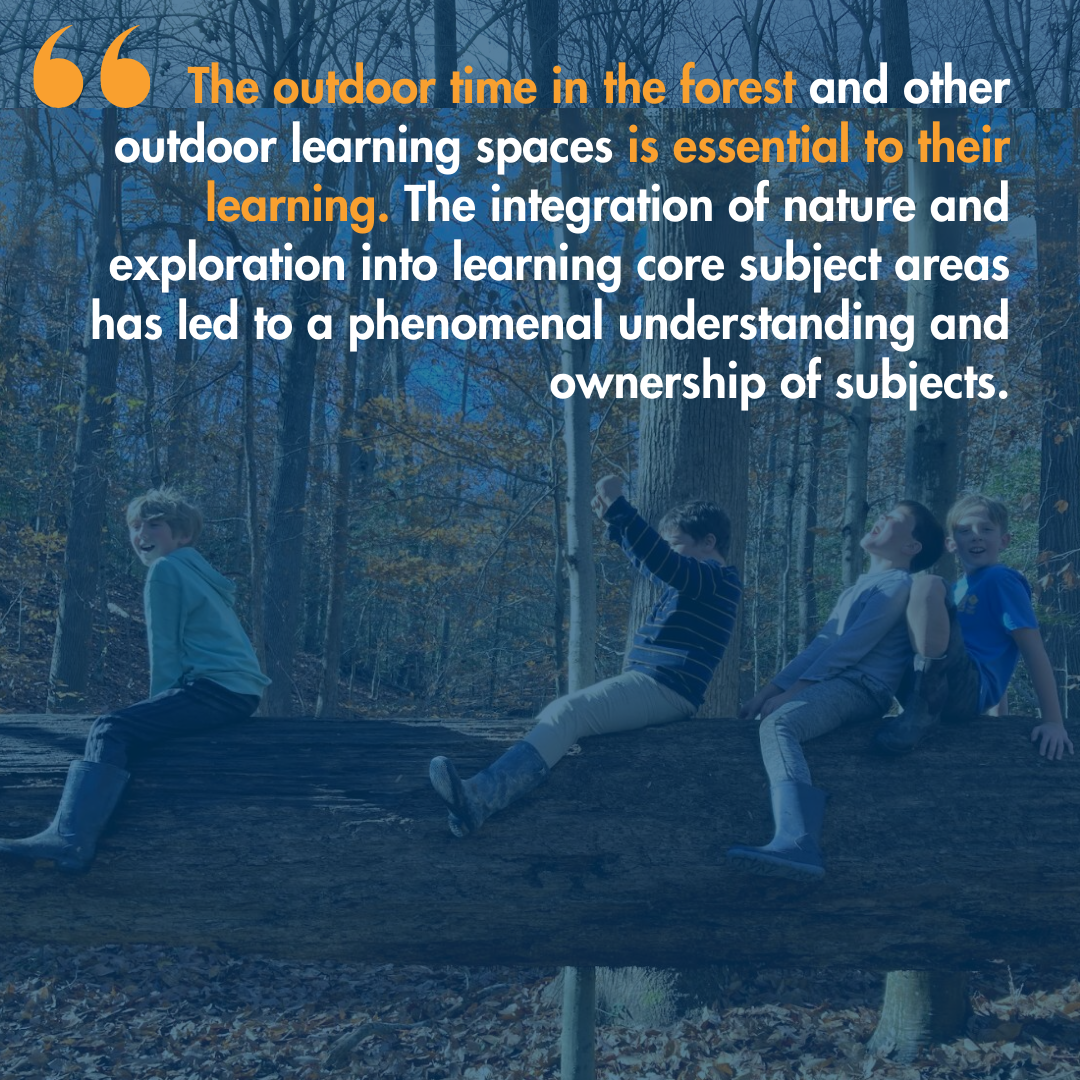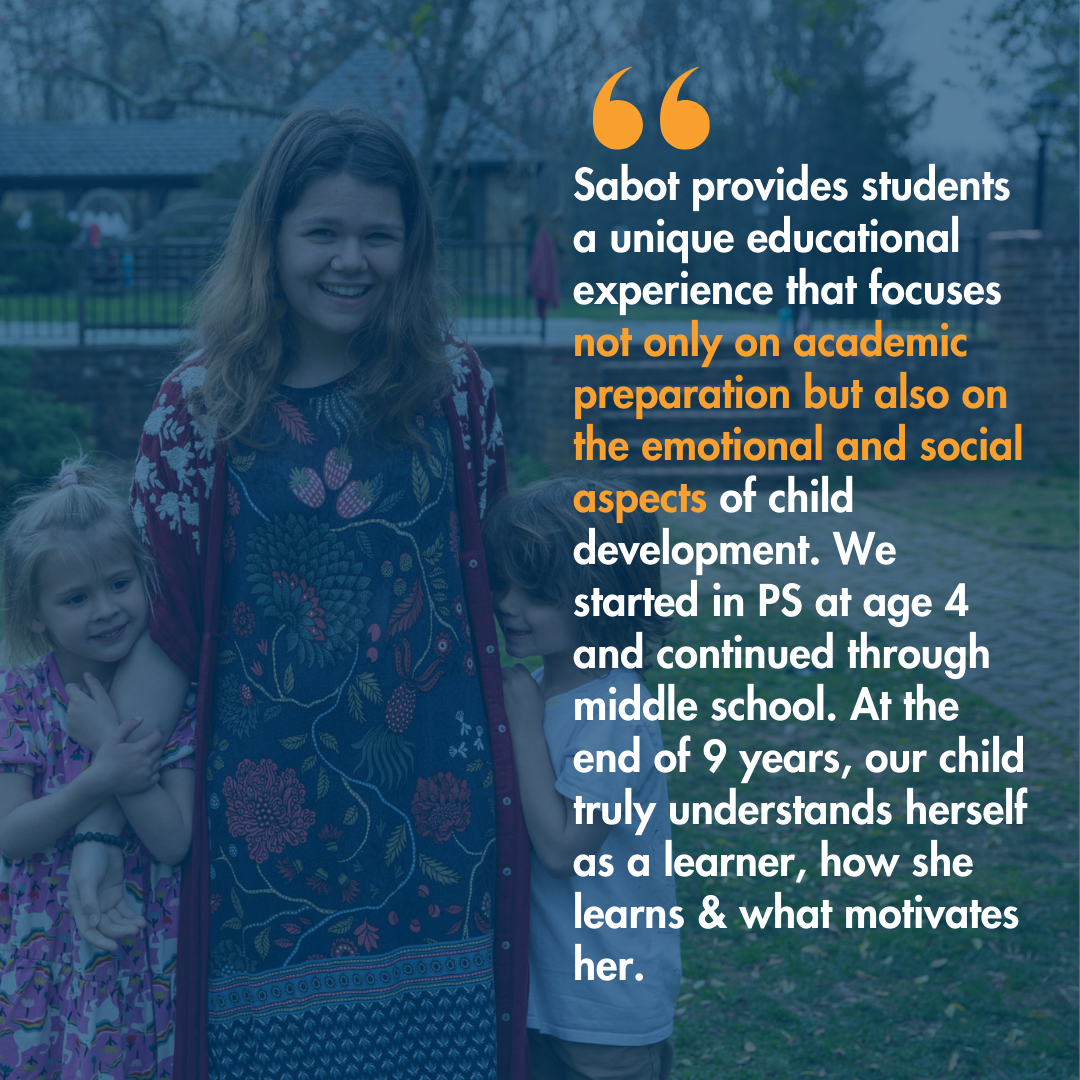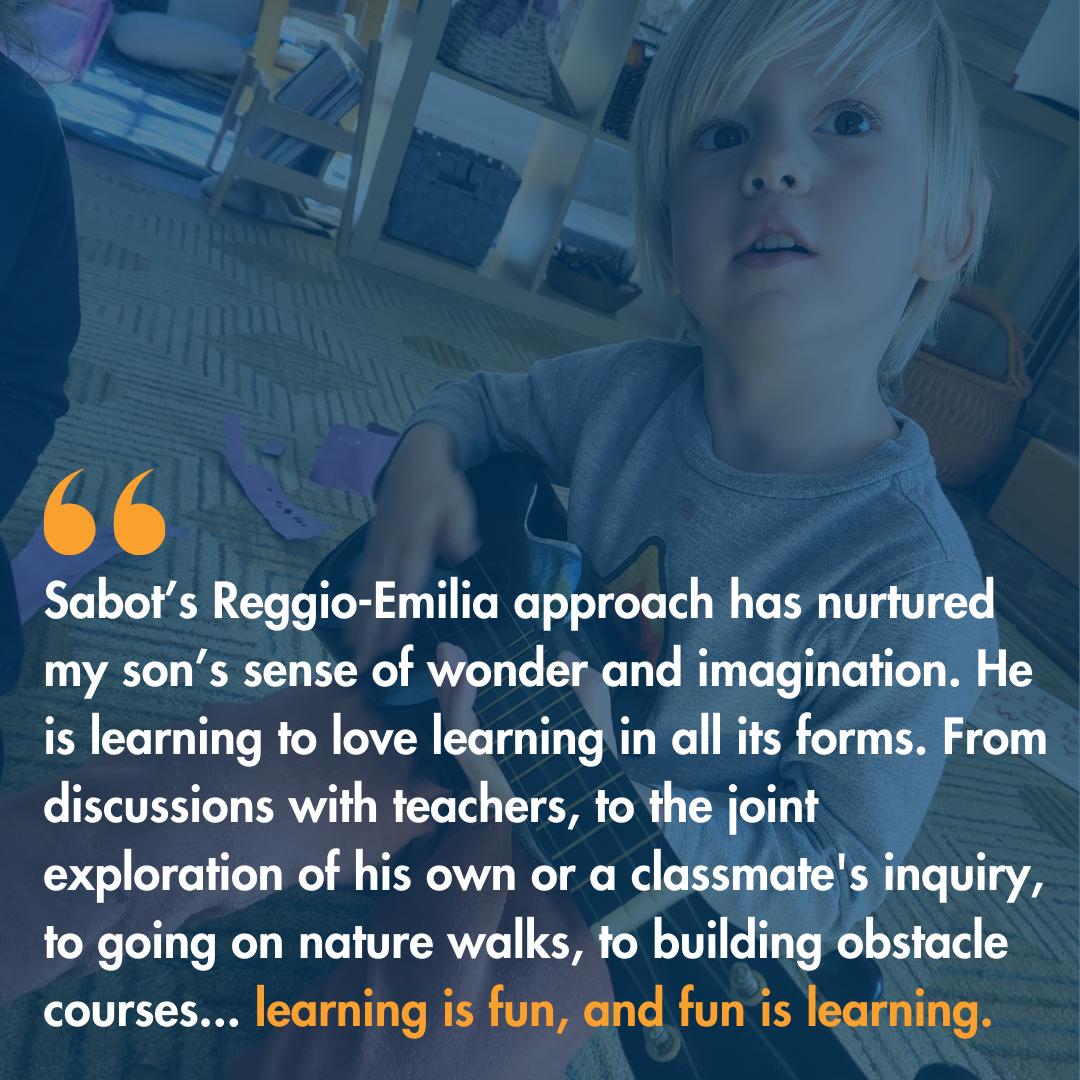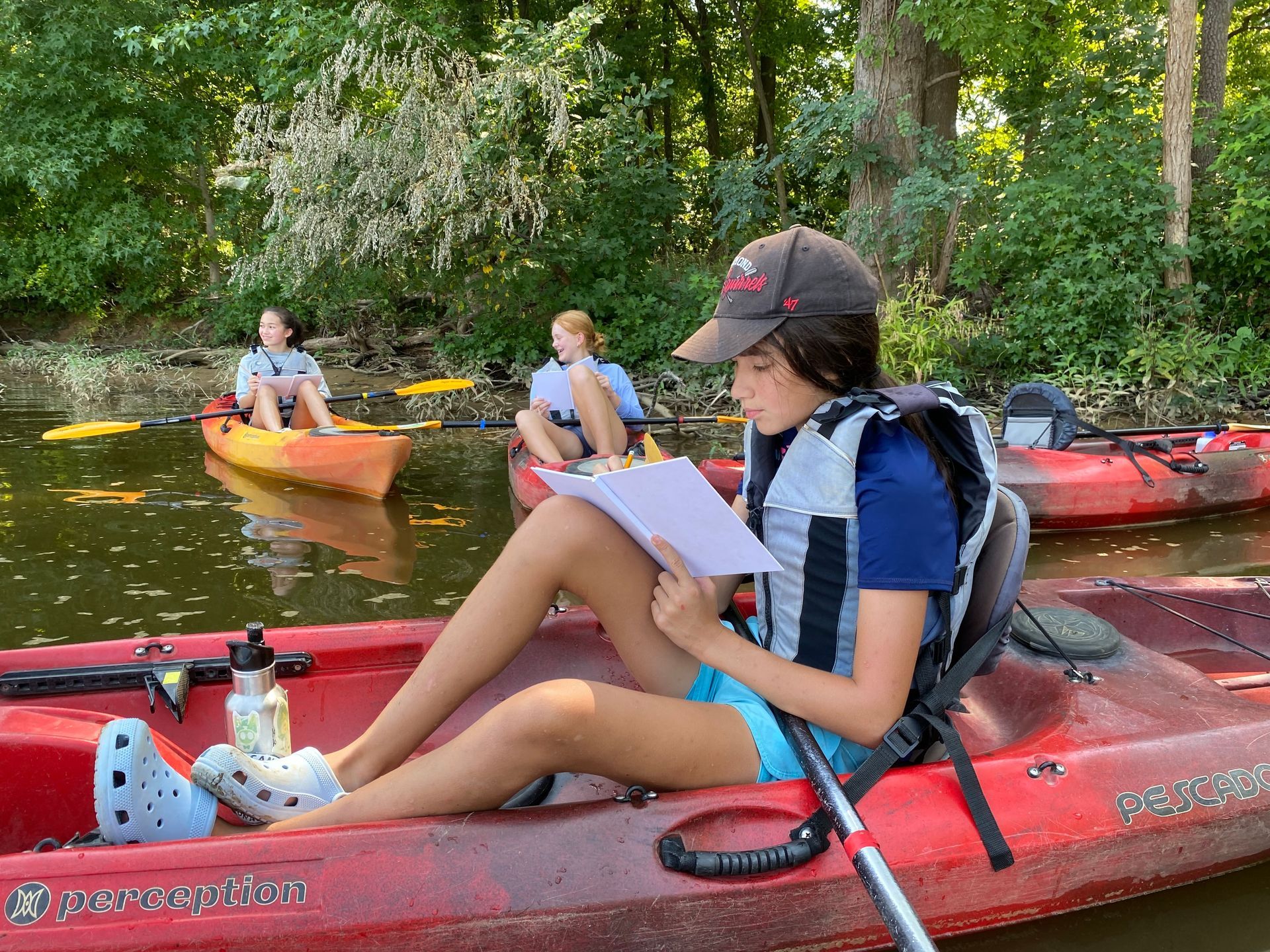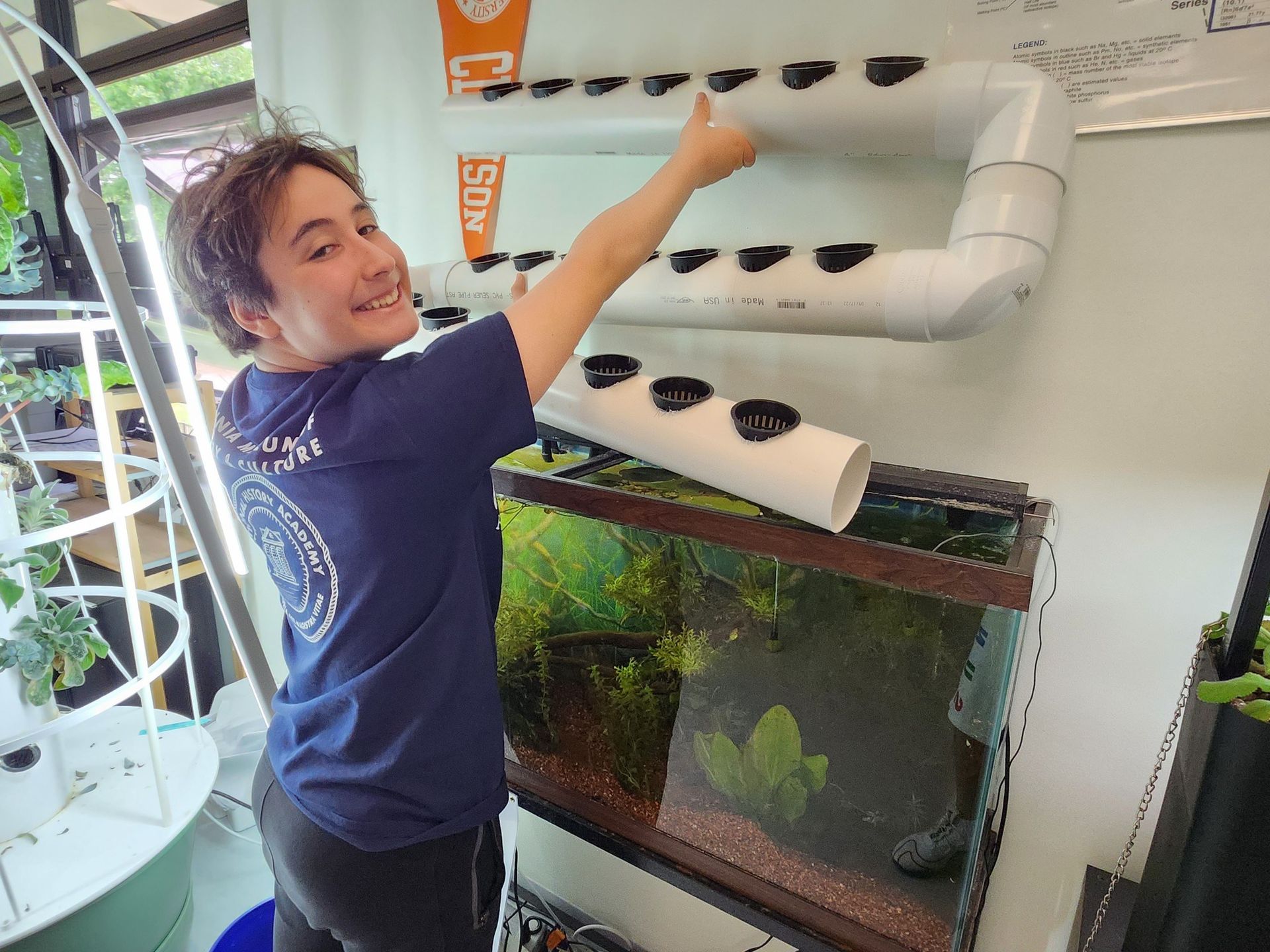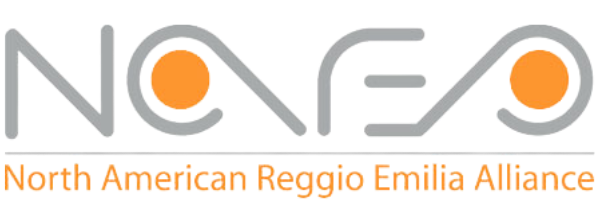Middle School at Sabot
What makes our Middle School program different?
Walk into our Middle School classrooms. You will find small workshops in which students are active, engaged, and purposeful. You will find students designing, developing, and executing their own projects in Exploratory, our innovative independent study program. You will see students presenting original research to peers. Sabot School is different for a reason, and our Middle School program is intentionally designed to foster curiosity, independence, and a genuine love of learning.
As much as possible, the work that middle school students do is connected to the real world; they address real problems, use real-world resources, and find multiple answers to their never-ending stream of real questions.
Learning in the Middle School is collaborative, investigative, and deeply intellectual. While content is essential – you can’t have genuine understanding without it – students also learn to develop the tools of inquiry and the habits of mind that will make them lifelong learners and problem-solvers. Students are encouraged and expected to approach their work with passion, intelligence, and creativity; we believe in depth over breadth. Our goal is not simply to transmit material, but rather to teach students how to think and communicate like historians, writers, mathematicians, scientists, and artists.
Sabot is accepting Middle School applications for the 2025-2026 school year
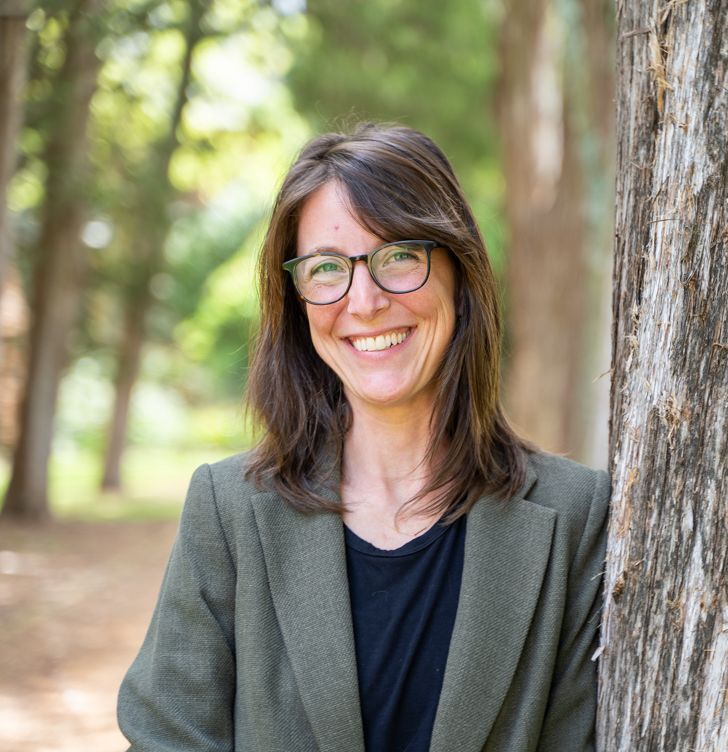
Meet Jess, 4-8 Program Director
Jess came to Sabot as a Middle School Science teacher-researcher and advisor and now serves as an essential member of the administrative team.
With a strong background in school leadership at the Middle School level as well as in experiential learning, she is passionate about engaging students in fieldwork and community action. While at the Brooklyn Urban Garden Charter School, she was the Director of Science, Sustainability and the Arts.
As part of the leadership team there, she managed the professional development program, developed curriculum and student assessments, worked with the Child Study Team, and was responsible for establishing and maintaining community partnerships.
She has additional experience supervising faculty teaching Science and STEAM, providing support as they align their work with the constructivist pedagogy and science standards. Jess and her wife reside in South Richmond with their dog, cat, and chickens.
A Progressive Curriculum:
How the Reggio Emilia Approach® Shapes Middle School Learning
In middle school, students experience significant cognitive, social, and emotional development as they begin to form their identities and navigate complex ideas. In grades 6 through 8 at Sabot, we blend the Reggio Emilia Approach™ with a standards-based curriculum to foster creativity, critical thinking, and independence. Rather than being passive recipients of information, students actively build their understanding by making connections, asking questions, exploring concepts, and reflecting on what they are learning.
This approach encourages students to take ownership of their education by seeking information, solving problems, and drawing conclusions based on their own thinking and experiences.
In the process, students develop not only a deep understanding of academic content but also a lasting love for learning and a sense of authority over their educational journey. Teachers act as guides and co-learners, facilitating discussions that challenge assumptions, promote problem-solving, and encourage self-reflection. Through projects, field studies, and student-led research, students acquire critical thinking, problem-solving, and self-reflection skills—tools they will carry into high school and beyond.
But how does this actually work in the classroom?
What sets our approach apart is not only what students learn, but how they learn it. Teachers at Sabot serve as curators, observing students’ interests and tailoring academic content to spark curiosity, while still meeting academic milestones. This personalized approach fosters a learning environment where students engage deeply with the material while developing a love for learning and a sense of ownership over their educational journey.
Assessment at Sabot is an ongoing, reflective process. Rather than relying solely on traditional tests, students track their progress through digital portfolios and student-led reflections, engaging in self-assessment and goal-setting along the way. Teachers evaluate academic content and essential skills like critical thinking, problem-solving, and collaboration through classroom observations, project work, and portfolios. Parent-teacher conferences, informed by this rich documentation, provide a holistic view of each student's development and progress.
STEM
At Sabot, STEM education integrates mathematics, science, and technology to foster critical thinking, problem-solving, and creativity in students.
- Mathematics: Students use the Connected Mathematics Project (CMP), a curriculum designed to develop mathematical knowledge and skills through real-world problem-solving. This program emphasizes connections between mathematical strands and links to other disciplines, helping students build a deep understanding of math as it applies across subjects. The curriculum includes Math 6 in 6th grade, Pre-Algebra in 7th grade, and Algebra 1 in 8th grade.
- Science: Guided by the Next Generation Science Standards (NGSS), students engage in inquiry-based learning that emphasizes both scientific skills and foundational content. The NGSS approach frames standards as performance indicators, ensuring students actively explore and practice the processes of science alongside mastering disciplinary knowledge. The curriculum includes Life Science in 6th grade, Physical Science in 7th grade, and Earth Science with Lab in 8th grade.
- Virginia Junior Academy of Science (VJAS): Middle school students participate in a rigorous, months-long scientific inquiry process, conducting experiments and summarizing their findings. Accepted papers are presented at the annual VJAS Symposium, where students share their work with judges and peers, building research, communication, and collaboration skills.
HUMANITIES
Sabot’s Humanities program combines Social Studies and Language Arts to help students explore their developing identities and engage with real-world issues.
- Language Arts: Students study a blend of contemporary works and classic texts, fostering critical thinking and connecting themes from diverse voices and perspectives. This approach encourages reflection on personal identity and larger societal questions.
- Social Studies: Through inquiry-based projects and discussions, students develop research, analysis, and literacy skills. They explore real-world problems and examine how individuals and communities drive change. The curriculum includes American Studies in 6th grade, Economics and Civics in 7th grade, and Honors Global Studies in 8th grade.
- Virginia History Day (VHD): As part of the curriculum, students participate in VHD, a program that challenges them to conduct in-depth historical research and create projects that showcase their findings. This process develops their skills in inquiry, analysis, and communication, while encouraging a deeper understanding of history's impact on the present.
- Focus on Justice and Change: Guided by their growing sense of fairness and responsibility, students use the tools of literacy and research to understand societal structures and consider ways to address inequities in their world.
EXPLORATORY INDEPENDENT STUDIES
Exploratory Independent Studies (or “Explo”) is a signature middle school experience at Sabot that empowers students to explore a personal interest or passion in depth.
- What Explo Looks Like: Students begin by crafting a guiding question and pitching their project idea. Once approved, they move on to plan and execute their independent projects, documenting their progress in multimedia portfolios. Over the semester, they experiment, problem-solve, and refine their ideas, culminating in a presentation to the middle school community where they share their process and outcomes.
- 100 Languages: A cornerstone of the Reggio Emilia Approach is the belief that children have 100 languages of expression. In Explo, students have access to all these modes of expression. Projects might include performing a monologue, creating a series of sculptures, designing a robot, composing an original song, writing a short story, or launching a business—students are limited only by their imagination. Whether building on an existing skill or exploring something entirely new, Explo encourages students to think creatively and take ownership of their learning.
- Mentorship -Throughout the process, students receive guidance from the 4-8 Atelierista, who provides both group instruction and one-on-one support, as well as an additional faculty mentor. The Atelierista helps students navigate the creative process and cultivate a maker’s mindset, while the faculty mentor works individually with students, offering expertise specific to their project. When challenges arise or projects fail, students are encouraged to reassess, adapt, and redirect their efforts—often discovering the most meaningful learning in these moments. Along the way, they develop self-awareness, critical thinking, and time management skills, all while taking responsibility for their learning journey.
- Maker Talks - Throughout the year, Sabot invites local “Makers” to campus to share their creative processes and innovations with students. Past guests have included SJ Sindu, a Sri Lankan American novelist, and Lowe Fehn, an interdisciplinary painter and poet. These talks provide students with inspiration and insight into how professional makers think and work.
This quote perfectly captures the essence of Explo:
"Think of it this way: There are two kinds of failure. The first comes from never trying out your ideas because you are afraid, or because you are waiting for the perfect time. This kind of failure you can never learn from, and such timidity will destroy you. The second kind comes from a bold and venturesome spirit. If you fail in this way, the hit that you take to your reputation is greatly outweighed by what you learn. Repeated failure will toughen your spirit and show you with absolute clarity how things must be done."
― Robert Greene, Mastery
ARTS
Middle School students in Grades 5-8 engage deeply with the arts through a combination of semester-long courses, a visiting artists program, and interdisciplinary exploration.
- Visiting Artist Program: Each year, visiting artists work with our middle school students, offering them the opportunity to learn directly from professionals in various disciplines. Students are enrolled in two semester-long courses each year, allowing for in-depth exploration of each subject. In 6th Grade, students begin with Tech II in the first semester and then move on to Drawing I in the second semester. In 7th Grade, students start with Music I, followed by Drama II. Finally, in 8th Grade, students take Drawing II in the first semester and Music II in the second semester.
- Arts Integration: The arts are woven throughout the Sabot experience as part of our Reggio Emilia Approach, which emphasizes representation through diverse media. The atelieristas (studio teachers) collaborate with classroom teachers to introduce new artistic techniques and modes of expression, integrating the "100 Languages" of learning into every subject.
- Explo and the Arts: Many students use their Exploratory Independent Studies (Explo) projects as an opportunity to dive deeply into the art medium of their choice, whether it’s drama, dance, visual art, or something else. This flexible, inquiry-based approach allows students to pursue their creative passions and take ownership of their learning.
FOREIGN LANGUAGE
The Sabot foreign language program focuses on developing proficiency in speaking, listening, reading, and writing, with an emphasis on communication. Students explore Hispanic cultures through art, music, and media, while acquiring language skills in a supportive and immersive environment, taught by a native Spanish speaker. The program builds progressively from beginner to intermediate levels, encouraging students to use Spanish in real-life situations and fostering global citizenship.
- 6th Grade Spanish (Spanish 1a): In 6th grade, students are introduced to basic Spanish vocabulary and grammar. They learn essential sentence structures, verb conjugation, and how to engage in simple conversations. The curriculum also introduces Hispanic culture through topics such as food, family, and geography. By the end of the year, students can introduce themselves, ask questions, and understand simple texts.
- 7th Grade Spanish (Spanish 1b): 7th graders build on the skills from 6th grade, expanding their vocabulary and grammar knowledge. They work on more complex sentence structures, explore the present and past tenses, and begin expressing opinions. Students also deepen their cultural understanding through topics like school life and sports, and are able to engage in basic conversations and interpret simple written and spoken texts.
- 8th Grade Spanish (Spanish 1c or Spanish 2): In 8th grade, students continue to refine their skills. Spanish 1c students deepen their understanding of verb tenses and sentence structures, while Spanish 2 students begin high school-level material, including the subjunctive mood and more complex grammar. Both groups engage with cultural topics like celebrations and current events, and practice real-world conversations, preparing for further study in high school.
- International Trips: Starting in 2024, Sabot organizes an bi-annual Panama trip for 7th and 8th grade students to provide an immersive cultural experience. This 8-day trip to Panama City and Portobelo includes visits to historical ruins, an Embera indigenous village, canoeing, snorkeling, and wildlife observation. Students will also participate in a cultural exchange. Financial aid is available for those who need assistance.
HEALTH & PHYSICAL EDUCATION
At Sabot, we believe that education goes beyond the academic. The social and physical development of our students is equally important, and we integrate these aspects into our curriculum to support the whole child.
- HHS (Health and Sexuality): In grades 4-8, students take a 6-week health course each year, covering topics like wellness, body systems, puberty, emotional health, relationships, and the effects of substances on their bodies.
- Physical Education: Students participate in physical education twice a week throughout the school year. The program focuses on building strength, cardiovascular fitness, and flexibility, while encouraging lifelong habits for physical well-being.
- Lunch & Recess: Students have 50 minutes of unstructured time each day for lunch and recess, providing an essential opportunity to build social skills, decompress, and engage in free play, which supports both emotional well-being and physical health.
ADVISORY, WORKSHOP BLOCK, & HIGH SCHOOL PREPARATION
In Middle School, Sabot students benefit from a robust support system designed to meet their academic and social-emotional needs while preparing them for the future. Through Advisory, Workshop Block, and High School Preparation, our program provides personalized guidance, skill-building opportunities, and a strong foundation for success.
- Advisory: In Middle School, the Advisor is the primary "go-to" person for students and their families. The Advisory Curriculum is designed to support both academic and social-emotional growth. Half of the week is dedicated to small group or one-on-one academic coaching, providing individualized support for each student. The other half of the week is focused on Community Circles, where students engage in group discussions about current events and explore the social-emotional ups and downs of adolescence, building a strong sense of community and connection.
- Workshop Block: A 40-minute study group occurring four times per week, where students practice skills designed to support their learning throughout the year. These inter-grade groups, developed by our faculty, focus on specific projects and learning objectives. Examples include Algebra I/Geometry I Prep, where students engage in advanced problem-solving to build a strong mathematical foundation; Editorial (Yearbook and Special Projects), where students collaborate to create the school’s yearbook; Research Skills, which sharpens nonfiction reading and evidence evaluation; and Maker Space, where students bring creative ideas to life using design and technology tools.
- High School Preparation: High school preparation begins in the second semester of 7th grade and continues through 8th grade. The Advisor, Division Director, School Counselor, and High School Placement Coordinator work closely with students and their families throughout the High School Placement process, providing guidance and support. As part of this process, 8th-grade students participate in six sessions of High School test prep in October, led by Susie Hudgins of Blooming Brain Coaching.
Sabot School is proud of our strong high school placement record, with nearly 100% of our graduates accepted into a variety of specialty programs throughout the Richmond area. Our students are admitted to schools such as Appomattox Regional Governor's School, Maggie L. Walker Governor’s School, Collegiate School, and the Math & Science High School at Clover Hill. This success is a testament to the support and strong academic foundation provided by our program. Click here to learn more about our high school placements.
FOREST TIME & OUTDOOR EDUCATION
At Sabot School, we believe that time spent outdoors is essential to a child’s development at all ages. Being in nature allows students to engage their senses, grapple with complexity, and build a deeper connection to the world around them.
As Richard Louv writes in Last Child in the Woods, “When you're sitting in front of a screen, you're not using all of your senses at the same time. Nowhere than in nature do kids use their senses in such a stimulated way”.
Middle School students at Sabot spend an average of five hours outdoors each week, whether during lunch, recess, classwork, or PE. Periods are intentionally 75 minutes long to accommodate project work and time in the forest. At least twice a week, students venture into the adjacent forest for science classes, where they explore, reflect, and connect their learning to the natural world. These experiences deepen their understanding of core concepts, while also fostering a sense of stewardship and curiosity.
ASSESSMENT & FEEDBACK
At Sabot, Faculty are designated as Teacher-Researchers, as in other Reggio-inspired schools. This is an intentional title that reflects our approach to documenting learning and facilitating a student’s ongoing inquiry and skill-building. In all grades, narrative reports are generated each semester to provide evidence of a student’s understanding, aligned to competencies or standards for Math and Language Arts (in 4th and 5th grades) and all core subjects (in Middle School). Evidence of student learning is collected through portfolios as well as teacher documentation.
In Middle School, students use their portfolios for ongoing reflection on their learning and to receive feedback from teachers. Students provide evidence of their understanding of various competencies and standards in each subject. This evidence can take the form of formal assessments or artifacts from project work. Teachers evaluate student understanding to differentiate learning targets and instruction. Students have the opportunity to revisit competencies and standards until they are confident in their understanding or ready to apply those skills in advanced contexts.
Each Unit of Study includes a pre-assessment and post-assessment, which students use to set goals and reflect on their progress. The MAP assessment is a common tool for evaluating proficiency in Reading and Mathematics across grade levels. It measures students' current proficiency according to Common Core Standards (the same standards used in Math and ELA). MAP data is used to inform targeted instruction and the design of Units of Study.
FIELD STUDIES
At Sabot School, we believe that learning doesn’t just occur in the classroom. Our Middle School students frequently embark on Field Studies—meaningful experiences that connect directly to the curriculum. Some of these are one-time visits, while others involve repeated trips that deepen understanding and extend learning.
For example, 8th graders students visit the Dutch Gap Conservation Area to kayak through wetlands while observing and recording the impact of conservation efforts. By returning to Dutch Gap quarterly, students can track changes over time, deepen their understanding, and see the real-world effects of their observations and actions.
Other examples of Field Studies include:
- Sustainability Unit: Students visited Green Swell Growers to explore a hydroponics facility and learn about sustainable agriculture.
- Civics Exploration: An annual trip to the United States Capitol provides students with the opportunity to witness government in action.
- Ecology Unit: Students partnered with the Chesapeake Bay Foundation to study the nitrogen cycle and local ecosystems while conducting water-based fieldwork.
- Air Quality Study: Students used air quality monitors to analyze conditions inside and outside Maymont Park and surrounding neighborhoods.
- Nutrition Unit: Students visited a grocery store to plan a nutritious meal for a specific family, applying their understanding of dietary requirements in a real-world scenario.
Through these experiences, students engage with the world around them in meaningful ways, fostering critical thinking, curiosity, and a deeper understanding of their studies.
5TH GRADE BRIDGE PROGRAM
The 5th Grade Bridge Program is designed to ease the transition from Lower to Middle School by gradually introducing students to the Middle School environment and routines. While 5th graders remain in their homeroom for Humanities and Studio, they transition to Middle School classrooms for Math and Science, where they experience co-taught classes with Middle School teachers.
As part of the program, 5th graders also participate in Middle School artist residencies and Workshop Block. These opportunities allow students to hone their skills in a multi-age environment that fosters peer connection and mentorship. By the end of the year, students are well-prepared for the academic and social challenges of Middle School.


